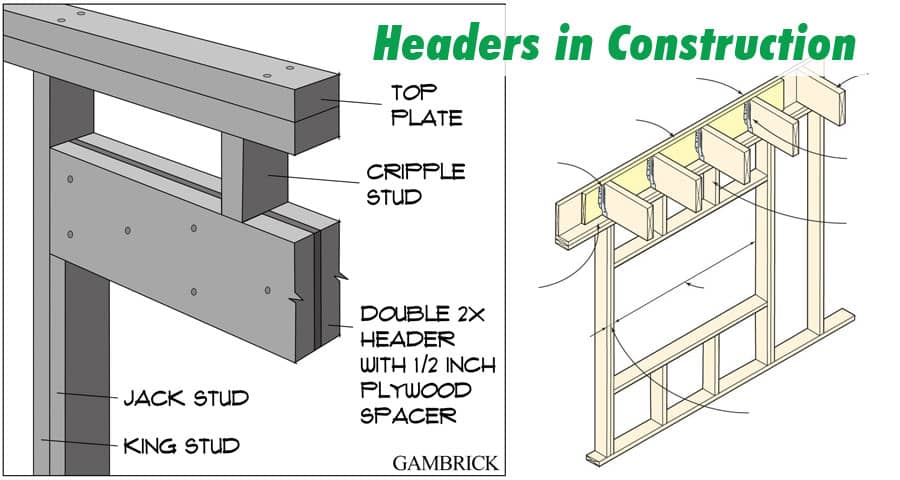Everything You Need to Know about Headers in Construction

In the realm of construction, every detail counts, and one often overlooked yet crucial element is headers. The importance of headers in construction cannot be overstated, as they play a pivotal role in ensuring structural integrity, providing support, and enhancing the overall safety of a building.
Understanding the Significance of Headers
Headers serve as load-bearing components within a structure, effectively distributing weight and providing support to openings such as doors and windows. Whether you are constructing a residential dwelling or a commercial space, headers play a critical role in preventing structural failure and ensuring the longevity of the building.
Types of Headers
- Wooden Headers: Wood has been a traditional choice for headers, prized for its versatility and ease of use. Wooden headers are particularly popular in residential construction, where their aesthetic appeal and natural warmth complement various architectural styles.
- Steel Headers: For projects demanding unparalleled strength and durability, steel headers stand out as a top choice. Ideal for large commercial buildings and structures with heavy loads, steel headers provide unmatched support, making them a preferred option in the construction industry.
- Concrete Headers: In instances where durability is paramount, concrete headers emerge as a reliable solution. These headers boast exceptional load-bearing capacity and resistance to environmental factors, making them suitable for projects where longevity is a key consideration.
Proper Installation Techniques
The effectiveness of headers lies not only in their material but also in the precision of their installation. Here, we outline essential tips for proper header installation, ensuring optimal performance and safety.
- Accurate Measurements: Before installation, meticulous measurements are imperative. Precision is the key to a successful header installation, and deviations from accurate measurements can compromise the structural integrity of the entire building.
- Secure Fastening: Whether you opt for wooden, steel, or concrete headers, secure fastening is non-negotiable. Utilize appropriate hardware and follow industry standards to guarantee the headers are firmly anchored in place, with no room for movement or instability.
- Professional Expertise: While some may attempt a DIY approach to header installation, it's recommended to seek professional expertise. A licensed contractor with experience in structural elements can ensure that headers are installed correctly, adhering to local building codes and regulations.
Common Issues and Solutions
Even with meticulous planning and execution, issues with headers can arise. Being aware of potential problems and their solutions is paramount in maintaining the structural integrity of your construction project.
- Sagging Headers: Sagging headers are a common concern, especially in structures with expansive openings. Reinforcement through additional support, such as braces or columns, can effectively address this issue, preventing long-term damage.
- Rot in Wooden Headers: Wooden headers are susceptible to rot over time, especially in regions with high humidity. Regular inspections and timely treatment with wood preservatives can significantly extend the lifespan of wooden headers, ensuring they remain sturdy and reliable.
Advanced Header Materials
As technology advances, so do the materials available for construction. Incorporating cutting-edge materials for headers can elevate your project to new heights of strength and sustainability.
- Laminated Veneer Lumber (LVL) Headers: Laminated Veneer Lumber, or LVL headers, are engineered wood products that offer superior strength and dimensional stability. Comprising layers of veneers bonded together with adhesives, LVL headers boast consistent strength properties, making them an excellent choice for projects requiring high load-bearing capacity.
- Fiber-Reinforced Polymer (FRP) Headers: For environments with high moisture or corrosive elements, consider using Fiber-Reinforced Polymer headers. FRP headers are resistant to water, chemicals, and insects, making them a durable alternative that extends the lifespan of your construction project.
Innovations in Header Design
- Integrated Insulation Headers: In the pursuit of energy efficiency, headers can now serve a dual purpose. Integrated insulation headers provide not only structural support but also contribute to thermal insulation, enhancing the overall energy efficiency of a building.
- Smart Headers: In the era of smart construction, headers can be equipped with sensors and technology to monitor structural conditions. Smart headers enable real-time data collection, allowing for proactive maintenance and early detection of potential issues.
Specialized Header Configurations
Beyond traditional applications, headers can be tailored to specific needs, introducing versatility in construction design.
- Flush Headers for Modern Aesthetics: In contemporary architecture, the desire for sleek designs has led to the adoption of flush headers. These headers align seamlessly with the surrounding structure, creating a visually appealing, modern aesthetic.
- Curved Headers for Architectural Flourish: For projects that demand a touch of architectural flair, curved headers offer a unique design element. These headers add a sense of sophistication and visual interest to the building, showcasing the possibilities of creative construction.
Sustainable Header Practices
With environmental consciousness on the rise, incorporating sustainable practices in construction is paramount. Headers can contribute to eco-friendly initiatives in several ways.
- Recycled Material Headers: Opting for headers made from recycled materials aligns with sustainable construction practices. Utilizing materials with a lower environmental impact reduces the carbon footprint of your project, contributing to a greener future.
- Efficient Design for Material Optimization: Minimizing waste through efficient header design is another sustainable practice. Advanced design software allows for precise calculations, ensuring that materials are optimized, reducing both cost and environmental impact.
For more information, please watch the following Video Tutorial
Source: LEVEL Engineering & Inspection
Conclusion
In conclusion, headers are a foundational element in construction that demands careful consideration. Understanding the various types, proper installation techniques, and addressing common issues are essential for ensuring the longevity and safety of any structure.
